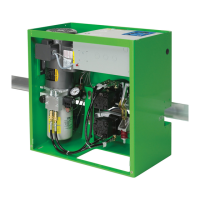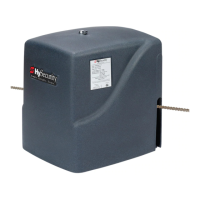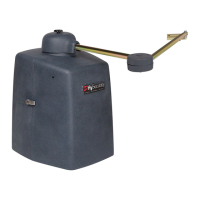www.hysecurity.com © 2019 Installing Gate Edge Sensors MX3630-01 Rev. J 103
Compatibility
The UL 325 Standard of Safety requires that an edge sensor be laboratory tested and “recognized” under UL
325. In order to be compatible with all HySecurity gate operators, a edge sensor must be rated to function
from 24 VDC source power.
A list of tested and approved external entrapment protection sensors (normally closed contacts) that are
compatible with HySecurity gate operators can be found online at the following public site: Gate Safety for
HySecurity Gate Operators.
Installation
NOTE: Follow the manufacturer’s installation and assembly instructions to properly mount the sensor. Wiring diagrams for several
sensor devices are found in Wiring HySecurity Sensors: Smart Touch on page 131.
HySecurity gates monitor normally closed (NC) sensors. Wire the NC sensors to SENSOR input terminals
(SENSOR 1, SENSOR 2, or SENSOR 3) on the Smart Touch Controller and set the Installer Menu item S1, S2,
or S3 to the appropriate setting for the area being monitored.
When using wired edge sensors, the wired edge must be connected to an interface module with an NC
output. ASO has UL 325 - 2016 compliant edge sensors. These edge sensors have a 10k Ω resistor that
connects to an interface module. The interface module provides the NC output for monitoring purposes. Refer
to Wiring HySecurity Sensors: Smart Touch on page 131.
For wireless edge sensors, no interface module is required. Wireless edge sensors need the wireless gate links
which include a transmitter and receiver. HySecurity has created kits for all-inclusive shipment.
NOTE: The installation locations are intended for pedestrian detection and safety. The potential zones requiring entrapment
protection are areas that need to be protected for pedestrian safety.
EDGE SENSOR INSTALLATION TIPS
• If edge sensors are used sliding gates, one or more contact sensors (edge sensors) must be located at
the leading edge, trailing edge and post-mounted both inside and outside of the sliding gate.
• Three-sided detectors are ideal for slide gates.
• If the clearance of the gate is 6” (15cm) or more above the road, then an edge sensor must be
mounted on the bottom edge.
• If gate is sliding open to a wall with less than 16” (41cm) of clearance, mount an edge sensor to wall
that aligns with gate in open position.
• Always route leads from edge sensors to gateoperator so that they are protected from physical
damage.
• Underwriters Laboratories requires that any contact sensor used as an external entrapment
protection device, must be laboratory tested to, and recognized to the UL 325 Standard.
• To enable monitoring of edge sensors, there must be a terminating resistor in the embedded in the
edge. This resistor is typically 8.2K or 10K and always has a small current draw to conrm that it is
installed.
• HySecurity gate operators must see a NC contact for monitoring purposes, therefore any edge sensor
with a terminating resistor will need an interfacing device to convert the resistor output into a NC
contact.
• Types of devices that will convert the resistor output to NC output include the Hy2NC, the WEL-200,
and the iGAZE RE.
• Hy2NC enables the Edge Sensor to be hard wired to the board.

